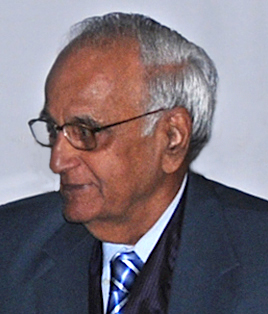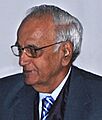R. D. Pradhan facts for kids
Quick facts for kids
Ram D. Pradhan
|
|
|---|---|

Pradhan in 2012
|
|
| 2nd Governor of Arunachal Pradesh | |
| In office 18 March 1987 – 16 March 1990 |
|
| Chief Minister | Gegong Apang |
| Preceded by | Bhishma Narain Singh |
| Succeeded by | Gopal Singh |
| Personal details | |
| Born | 27 June 1928 |
| Died | 31 July 2020 (aged 92) |
Ram D. Pradhan (born June 27, 1928 – died July 31, 2020) was an important Indian government officer. He was part of the Indian Administrative Service (IAS), which is a group of top civil servants in India. He worked as the Union Home Secretary and later as the Governor of Arunachal Pradesh. He was known for helping to sign two important peace agreements: the Assam Accord and the Mizo Accord. Mr. Pradhan worked for the Indian government for 36 years in various high-level roles.
He started his career in the state of Bombay (now Maharashtra) in 1952. He also worked in Gujarat and served as a private secretary to India's Defence Minister. For ten years, he represented India in international trade talks in Geneva. He held many key positions, including Home Secretary and Chief Secretary for the state of Maharashtra. In 2008, he was asked to lead a team investigating the 2008 Mumbai attacks. He passed away in 2020 at the age of 92.
Contents
Union Home Secretary
In 1984, Rajiv Gandhi became the Prime Minister of India. He was impressed by Mr. Pradhan's quick and effective work in handling difficult situations, like the 1982 riots in Bhiwandi. Because of this, Prime Minister Gandhi invited Mr. Pradhan to work for the central government. In 1985, Mr. Pradhan became the Union Home Secretary, a very important job in charge of internal security. He held this position until he retired in 1986.
During his time as Home Secretary, he worked closely with the Home Ministers S. B. Chavan and Buta Singh.
Helping Punjab
One of Mr. Pradhan's first big tasks as Home Secretary was to understand the difficult situation in Punjab in 1985. There were groups in Punjab asking for a separate country called Khalistan. The situation was very tense after Operation Blue Star and the assassination of Prime Minister Indira Gandhi.
Mr. Pradhan suggested that the government should talk to the Akali Dal party again. He also advised changing the Governor of Punjab to someone with a political background. This led to Arjun Singh becoming the new Governor. Mr. Pradhan also suggested involving Sharad Pawar, a well-known politician, in the talks. This helped bring the Akali Dal party back into mainstream politics.
Mr. Pradhan also checked if Punjab was ready for elections. He helped arrange meetings with young leaders to understand their feelings. When elections were held, the Akali Dal party won and formed the government.
The Punjab Accord
Mr. Pradhan was also involved in putting the Punjab accord into action. This agreement was about deciding which Hindi-speaking areas of Punjab would go to Haryana, in exchange for Chandigarh becoming permanently part of Punjab.
He helped a special commission that was trying to decide this. When there were disagreements about counting people in a village, Mr. Pradhan sent security forces to ensure a fair count. He even chose 30 young IAS officers from different parts of India to do the counting. This showed his dedication to fairness.
Even though several commissions tried, a final solution for the land exchange between Punjab and Haryana was not fully reached. Chandigarh remains a shared capital for both states.
The Assam Accord
In Assam, student groups like the AASU were protesting against people coming into the state from Bangladesh and Nepal. Talks to solve this problem had been going on since 1980 but had stopped.
In April 1985, Prime Minister Rajiv Gandhi asked Mr. Pradhan to restart these talks. Mr. Pradhan invited AASU leaders to Delhi in May 1985. He held many secret meetings with them. They discussed how to identify and deal with people who had entered the state illegally.
Mr. Pradhan worked hard to get an agreement. He kept the talks private, even from the Chief Minister of Assam. He used the deadline of India's Independence Day (August 15) to encourage everyone to agree quickly. On August 15, 1985, the Assam Accord was signed. Prime Minister Rajiv Gandhi announced it in his Independence Day speech.
After the accord, the AASU formed a political party called Asom Gana Parishad. This party won the elections in Assam in December 1985.
The Mizoram Accord
In August 1985, Rajiv Gandhi also asked Mr. Pradhan to talk with Laldenga, the leader of the Mizo National Front. Laldenga's group had been fighting for their land to become separate from India. They had signed an agreement in 1976, but it was never fully carried out.
Mr. Pradhan started direct talks with Laldenga in September 1985. The talks were difficult at first. Mr. Pradhan worked slowly and steadily. In June 1986, as he was about to retire, Mr. Pradhan pushed for a quick solution.
On June 30, 1986, his retirement day, Mr. Pradhan convinced Laldenga to be flexible. Within an hour, all the remaining issues were solved, and the agreement was ready. Prime Minister Rajiv Gandhi wanted Mr. Pradhan to sign the accord before he retired. So, his retirement was delayed by a few hours. The Mizoram Accord was then signed by Mr. Pradhan, Laldenga, and the Chief Secretary of Mizoram.
Governor of Arunachal Pradesh
In March 1987, Mr. Pradhan was appointed the second Governor of Arunachal Pradesh. Arunachal Pradesh had just become a state in November 1986. At that time, the state had border issues with China. Prime Minister Rajiv Gandhi chose Mr. Pradhan because of his success in the Assam and Mizoram accords, and his experience in defence matters.
When V.P. Singh became Prime Minister in 1990, he asked all state governors to resign. Mr. Pradhan was the first governor to submit his resignation.
Other Roles
After his government service, Mr. Pradhan won a seat in the Maharashtra Legislative Council in June 1990. This is a part of the state's government.
Positions Held
Here are some of the important jobs Mr. Pradhan held:
- Governor, Arunachal Pradesh: March 1987 – March 1990
- Home Secretary, India: January 1985 – June 1986
- Home Secretary, Maharashtra: 1977
- Chief Secretary, Maharashtra
- Private Secretary to Y.B. Chavan (Chief Minister of Maharashtra and Defence Minister of India): 1960–1965
- India's Representative in Geneva for UN trade organizations: 12 years
- Assistant Collector and Sub-Divisional Magistrate, Mount Abu
- Chairman of the High-level Enquiry Commission for 26/11 (investigating the 2008 Mumbai attacks).
Awards
Mr. Pradhan received the Padma Bhushan award on Republic Day in 1987. This is one of India's highest civilian honors, given for distinguished service to the nation.
Images for kids


